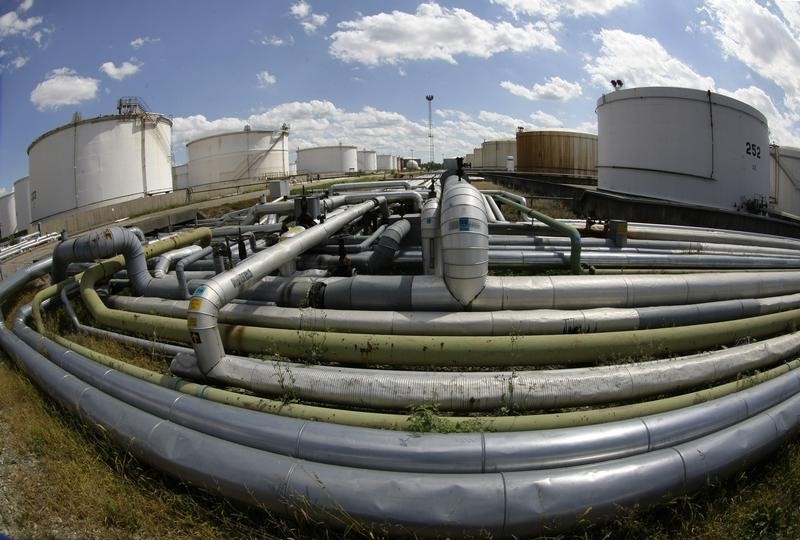Investing.com - Oil prices eased in Asia on Thursday after data from the U.S. Department of Energy showed a weaker drop in stockpiles than expected and markets viewed remarks from the Fed as downbeat for demand prospects.
On the New York Mercantile Exchange, WTI crude for July delivery dropped 1.10% to $47.48 a barrel.
On Wednesday afternoon, the Federal Open Market (FOMC), as expected, left the target range of its benchmark Federal Funds Rate unchanged at a level between 0.25 and 0.50%. It marked the fourth consecutive meeting the FOMC held rates steady at their current level since their historic rate hike in December. The FOMC voted unanimously 10-0 to support the monetary policy action. Previously, Kansas City Fed president Esther George served as the lone dissenter at FOMC meetings in March and April.
"The Committee currently expects that, with gradual adjustments in the stance of monetary policy, economic activity will expand at a moderate pace and labor market indicators will strengthen," the FOMC said in the statement. "Inflation is expected to remain low in the near term, in part because of earlier declines in energy prices, but to rise to 2 percent over the medium term as the transitory effects of past declines in energy and import prices dissipate and the labor market strengthens further."
The new projections aren't set in stone, but they do indicate how the views of officials are changing. The Fed doesn't see rates going as high as it saw before, and it sees taking a longer time to get to the endpoint officials have in mind.
Markets pushed back expectations for a summer rate hike by the U.S. central bank after a dismal U.S. employment report for May, which showed the slowest rate of jobs growth since September 2010.
"Oil prices have had many different effects on the economy, so we have been watching oil prices closely. Falling oil prices pull down inflation, it takes falling oil prices to lower inflation on a sustained basis," Fed chair Janet Yellen said at a news conference on Wednesday. "Once they stabilize, their impact on inflation dissipates over time -- not only have they stabilized, they have moved up some. Their impact on inflation is waning over time."
The Fed chief also noted the impact of oil prices on policy.
"Oil prices have had many different effects on the economy, so we have been watching oil prices closely. Falling oil prices pull down inflation, it takes falling oil prices to lower inflation on a sustained basis," Fed chair Janet Yellen said at a news conference on Wednesday. "Once they stabilize, their impact on inflation dissipates over time -- not only have they stabilized, they have moved up some. Their impact on inflation is waning over time."
Overnight, U.S. crude futures slumped to 3-week lows on Wednesday after the Energy Information Administration defied expectations with a lower than expected stockpile draw last week.
On the Intercontinental Exchange (ICE), Brent crude for August delivery wavered between $48.68 and $49.80 a barrel, before settling at $48.89, down 0.92 or 1.85% on the day.
On Wednesday morning, the EIA said in its Weekly Petroleum Status Report that U.S. commercial crude oil inventories decreased by 0.9 million barrels for the week ending on June 10. At 531.5 million barrels, U.S. crude oil inventories are at historically high levels for this time of year.
While analysts initially expected a draw of 2.3 million barrels, they lowered their expectations following reports of a 1.518 million build by the American Petroleum Institute on Tuesday evening after the close of trading. Total motor gasoline inventories decreased by 2.6 million barrels last week, while distillate fuel inventories increased by 0.8 million barrels.
The Cushing Oil Hub in Oklahoma, the nation's largest storage facility, reported a build of 0.904 million barrels last week.
Supply levels at Cushing, the main delivery point of NYMEX oil, remains perilously close to reaching full storage capacity. A week earlier, WTI crude surged above $51 a barrel after a massive inventory decline of 3.2 million barrels.
Meanwhile, domestic crude production last week fell sharply by 29,000 barrels per day to 8.716 million barrels per day. It came one week after crude output rose moderately by 10,000 bpd to 8.745 million, halting a four-month streak of weekly declines. Over the last year, crude production in the U.S. has fallen by nearly 1 million bpd from its level last June when hovered near 40-year highs.
